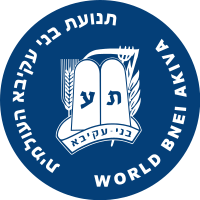Organization:Bnei Akiva
 World Bnei Akiva logo | |
| Formation | May 28, 1929 |
|---|---|
| Type | Jewish Youth Movement |
| Legal status | Non-profit organization |
| Purpose | Educational |
| Headquarters | Jerusalem, Israel |
| Location |
|
| Coordinates | [ ⚑ ] 31°46.892′N 35°12.988′E / 31.781533°N 35.216467°E |
Region served | Worldwide |
Members | ~125,000 |
Secretary General | Ohad Tal |
Parent organization | Hapoel HaMizrachi |
Staff | 25 (2016) |
| Website | www |
Bnei Akiva (Hebrew: בְּנֵי עֲקִיבָא, /bneɪ əkivə/, "Children of Akiva") is the largest religious Zionist youth movement in the world, with over 125,000 members in 42 countries. It was first established in Mandatory Palestine in 1929.[1]
History
Bnei Akiva was established on Lag BaOmer 1929 as the youth wing of the Mizrachi movement. Concurrent with the establishment of the movement in pre-independence Israel, organizations of religious youth operated in the Diaspora.[2] In 1958, the Israeli and Diaspora groups merged to form the modern World Bnei Akiva, which operates both in and out of Israel for Diaspora youth, along with Bnei Akiva Israel, which operates in Israel for Israeli youth.
Ideology
Bnei Akiva's objectives are to educate Jewish youth with values of Torah and work, to provide stimulating experiential and informal opportunities for encountering Judaism, and to encourage Jewish continuity and leadership. Bnei Akiva's twin ideals of Torah and Avodah translate to religious commitment and work on the land of Israel. Bnei Akiva believes in emigration to the land of Israel (Aliya) as a central commandment of Judaism, and maintains that the future of the Jewish people is tied to the state of Israel.[3] In the organization's early years, Avodah was understood as meaning agricultural work, as reflected in the symbolism of the movement's emblem. In more recent years, there has driven a shift in ideology towards a broader definition of working for the development of the country. Members are encouraged to spend a year in Israel on organized learning and touring programs to broaden their knowledge of Israel and developing their leadership skills.
Similarly, the original socialist aims of Bnei Akiva are less actively pursued. Until the 1980s many Bnei Akiva members joined religious Kibbutzim in groups based on mutual army service or Aliya. Since the 1990s, Bnei Akiva members now typically settle in development towns and settlements.
Bnei Akiva actively promotes moving to the state of Israel in a process called aliya (literally meaning "to go up"), but the way in which this occurs has changed over the years. Until the 1990s, chanichim (trainees, disciples) were encouraged to make aliya in garinim (kernels, small groups) intended to bolster existing communities. These were almost always directed to a Kibbutz Hadati, and fierce debates took place as to whether any other form of aliya was a valid expression of the movement's ideals. Today[when?] the push for aliya is more general, with no specific communities or framework in mind. The focus is more on coming to Israel and contributing positively to society in any way.
Organizational framework
In Israel, Bnei Akiva is affiliated with the Religious Kibbutz Movement. It is run by a National Secretariat (Hanhala Artzit). Outside Israel, local branches of Bnei Akiva are under the Bnei Akiva Olami (Worldwide) organization. In every country, Bnei Akiva operates a network of Shabbat groups, summer camps, leadership seminars, Shabbatonim, and other activities.
Each age group from third grade to eighth grade has a section common to all scouts of the youth movement in Israel and around the world.
Camp Moshava
Bnei Akiva of the United States and Canada sponsors summer camps, known as Camp Moshava. The first Moshava, in Hightstown, New Jersey, was established in 1936. The largest camp is located in Texas Township, Pennsylvania, with 1,500 campers and 400 counselors.[4]
Symbols of Bnei Akiva
Emblem
Bnei Akiva's emblem displays wheat and farming tools (such as scythe and pitchfork), symbolizing the agricultural perspective of the ideology. It also shows the Tablets of Stone, displaying two letters of the Hebrew alphabet that stand for Torah VeAvoda, which means "Torah and work". The two perspectives of Torah and Avoda are tied together by the ribbon which displays the text "Bnei Akiva" on it.[5]
Mifkad
Bnei Akiva branches all over the world start or end their meetings with mifkad, forming the letter Heth (Template:He, a rectangle missing one of its smaller sides) using the participants. The mifkad is the assembly where announcements are made, members are counted and the ideology is reaffirmed. With slight variations, the text of mifkad is the same all over the world, following a basic structure.[6]
See also
References
- ↑ "Jewish Youth Movements in Israel". https://www.jewishvirtuallibrary.org/jsource/Society_&_Culture/Youth.html.
- ↑ "Yad Vashem – Bnei Akiva". http://www1.yadvashem.org/exhibitions/lodz/pop6.html.
- ↑ "About Bnei Akiva". http://www.bneiakiva.org/about/.
- ↑ Sones, Mordechai (May 7, 2018) "15,000 Children to Attend Bnei Akiva Summer Camp in 16 Countries", Israel National News. Retrieved May 24, 2020.
- ↑ "Bnei Akiva Sydney Australia". http://www.wej.com.au/bnei/bnei_home.html.
- ↑ "Mifkad for the Bnei Akiva Movement". 2011-07-25. http://www.bneiakiva.org/pub/Basics-Mifkad.pdf.
External links
- Bnei Akiva of the US and Canada
- World Bnei Akiva
- Yeshivot Bnei Akiva – In Israel (Hebrew)
- American Friends of Yeshivot Bnei Akiva
- Bnei Akiva UK
 |


